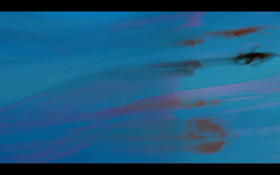But where they faltered was in not embracing the adult elements more. I think Disney is afraid to change their formula and truly create a film that can be seen solely as an artistic endeavor. With millions to be made in merchandise and other promotional tie-ins, a film that does't appeal to all ages is too risky. But in trying to appeal to all, it dilutes the possibility of ever being taken seriously as art. (The studio later did it again when they scrapped plans to make an epic film about the Incas called The Kingdom of the Sun and turned it into the childish–but I'll admit, pretty hilarious–Emperor's New Groove.) Every time the antics of the animal sidekicks come into play in Pocahontas, the film screeches to a halt and turns aways from what it wants so badly to be. (Although it could have been worse, the animals were originally supposed to talk and Pocahontas' main sidekick was to have been a turkey named Redfeather voiced by John Candy.)
What saves the film from being a complete miss is the stunning artwork. The gorgeous backgrounds of pastel-hued forests, blazing sunsets, and cool, misty waterfalls create a bucolic atmosphere so lush that you do feel a hurt when the settlers begin to destroy it. I remember my aunt remarked after seeing the film that it was how she imagined heaven would look. But it's Supervising Animator Glen Keane (who was also responsible for Ariel, the Beast, Aladdin, and Tarzan among others) and his work on Pocahontas that remain the film's crowning achievement.
Let's start with the hair. Has any other element in a Disney film ever been so mesmerizing? Constantly in motion as if Pocahontas has one of Beyoncé's music video wind machines on her at all times, it whips about, it glides, it flows and practically becomes a character onto itself. Symbolizing her restless spirit, her blue-black mane entwines with the wind bringing her closer to nature and her mother (Powhatan says early on in the film that he feels her presence whenever the wind blows through the trees). And Keane's manipulation of it makes it seductively come alive. But it's his attention to detail, the way he effortlessly and elegantly treats it–the way she runs her hand through it when she goes to see Grandmother Willow, how she tucks it behind her ear while pondering Smith's outstretched hand, how she nervously begins to braid it while thinking about these strange new feelings inside her–that shows what a master of the form he is.
Since the earlier days of animation, the philosophy seemed to be the bigger and broader the better. But what Keane does with Pocahontas, trusting in the stillness and the power of a slight gesture, gives her a complexity and humanity rarely found in animation. The best scene of the film has to be when John Smith sees her for the first time at the waterfall as she silently looks at him. There's a power in her eyes, as if there are thoughts behind them. We're no longer looking at moving drawings, but being moved by the drawings.










LOL, this movie was kind of a mess, but it is visually stunning. Great choice for an image too!
ReplyDeletehaha. thanks! yeah, it was definitely a missed opportunity, but there's no denying it's beauty.
DeleteGood choice. I agree that Pocahontas is one of the most beautiful Disney characters as far as design and animation goes.
ReplyDeletethanks, conrado! yeah, i think she may actually be my favorite. just don't ariel, my 8 year-old self would feel betrayed...
DeleteGreat post and I pretty much agree with you on all of it! Also, way to also use the phrase "wind machine" when describing how nature coddles her majestic mane. :D
ReplyDeletethank you, ryan! i really enjoyed writing it. i was a little obsessed with pocahontas back when it came out. if only i had my own personal wind machine...
Delete